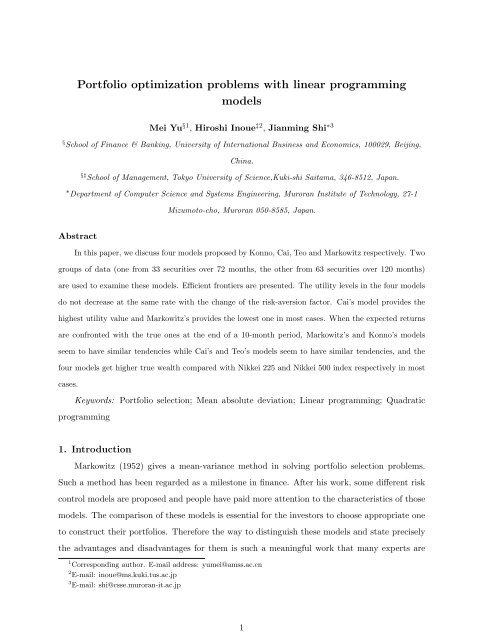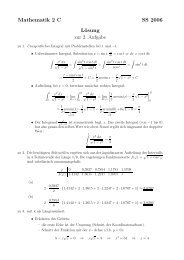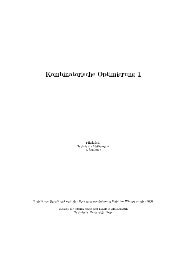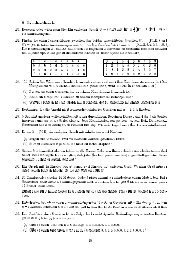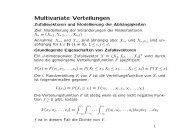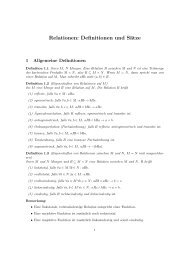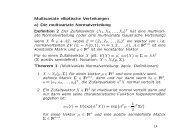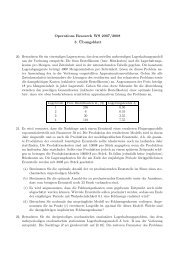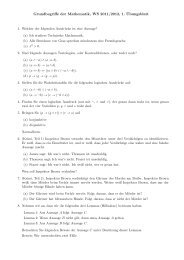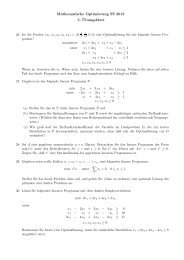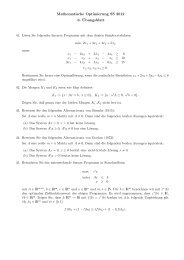Portfolio optimization problems with linear programming models
Portfolio optimization problems with linear programming models
Portfolio optimization problems with linear programming models
- No tags were found...
You also want an ePaper? Increase the reach of your titles
YUMPU automatically turns print PDFs into web optimized ePapers that Google loves.
kth-order target risk is defined as BT k (ρ, x) = E[(ρ − R(x)) k −] 1 k .This risk measure will be fit into the MEU principle (Fishburn,1977). For any k, BT k (ρ, x)is convex. When k = 1, 2, the portfolio model can be transformed into <strong>problems</strong> of <strong>linear</strong> <strong>programming</strong>and quadratic <strong>programming</strong> respectively, which is extremely important in proceedingthe real computation.Konno and Yamazaki (1990,1991) present Mean Absolute Deviation (MAD) model.Definition 4 Absolute deviation is defined as followsn∑n∑l 1 (x) = ER j x j − E[ R j x j ]∣∣ .j=1The main characteristic of this model is that the risk of a portfolio is measured by theabsolute deviation of the return rate of assets instead of the variance. Much attention has beenfocused on this risk function because the portfolio <strong>optimization</strong> problem <strong>with</strong> l 1 risk function canbe converted into a scalar parametric <strong>linear</strong> <strong>programming</strong> problem. Hence, the implementation ofthe portfolio <strong>optimization</strong> <strong>with</strong> this model can be easily obtained. Simplicity and computationalrobustness are perceived as one of the most important advantages of the MAD model. Till now,many excellent properties of this model have been found and some of them are referred to here..0It is pointed out that the MAD model takes on an opportunity to make a more specificmodel such as the downside risk because absolute deviation may be regarded as a measure ofthe downside risk (Konno,1990; Feinstein and Thapa, 1993).It is known that if the return is multivariatly, normally distributed, the minimization of theMAD provides similar results as the classical Markowitz formulation, and minimization of MADis equivalent to maximization of the expected utility under risk aversion (Rudolf et al, 1999).Markowtiz model has been criticized as not being consistent <strong>with</strong> axiomatic <strong>models</strong> of preferencesfor choice under risk because it does not depend on a relation of stochastic dominance(Whitemore and Findlay, 1978; Levy, 1992). In contrast, the MAD model is consistent <strong>with</strong>the second degree stochastic dominance, provided that the trade-off coefficient between risk andreturn is bounded by a certain constant(Ogryczak, 1997).Ogryzak and Ruszczynki (1999, 2001) proved that the most optimal solution in efficientfrontier of MAD model satisfies the MEU principle no matter how (R 1 , . . . , R n ) is distributed.At the same time, the capital asset pricing model for the l 1 risk model is derived by Konno(1991) where the risk function is assumed to be differentiable at the market portfolio. Withoutimposing differentiability on the l 1 risk function, equilibrium relations were given by Konno andj=13
Shirakawa (1994).Moreover, since the <strong>optimization</strong> problem <strong>with</strong> MAD is always transformed into a <strong>linear</strong><strong>programming</strong> problem, the model can easily be extended to a frictional case ( Konno andWijayanayake, 1999, 2001a, 2001b and 2002), while the mean variance model may be moredifficult for these cases. Since there are so many advantages in the MAD model, it is worthdiscussing and considering its extension.Cai et al (2000) gives a new risk model based on MAD. He introduces the minimax rule inthe portfolio selection model.Definition 5 The maximum absolute deviation risk model l ∞ is given asl ∞ (x) = max16j6n E |R jx j − E(R j )x j | .In this model, the investor is assumed to minimize the maximum of individual risk. Theexplicit analytical solution for the model is presented and the entire efficient frontier is alsoplotted.The author points out that such a risk model is very conservative and it does notexplicitly involve the covariance of the asset returns.Definition 6 The alternative l ∞ risk function is defined as:H T ∞(x) = 1 TT∑max E |R itx i − r it x i | ,16i6nt=1where R it is random variables and r it is the expected value of R it , for i = 1, . . . , n, t = 1, . . . , T .This function is an extension of l ∞ (x), and it is assumed that the available historical dataare split into T periods. In each period, the individual absolute deviation <strong>with</strong> respect to theexpected value of the period is calculated. The total risk of the portfolio is taken as the averageof the maximum (over all assets) of these individual absolute deviations over all periods.It is worth noting that Papahristodoulou and Dotzauer (2004) compared Markowitz’s QPmodel, Konno’s MAD model and Young’s Maximum model . They found that the maximinformulation yields the highest return and risk, while the QP formulation provides the lowestrisk and return. And it is also pointed out that the minimization of mean abosolute deviation isclose to the QP formulation. They conclude that the maximum portfolios seem to be the mostrobust of the three <strong>models</strong> when comparing the expected returns <strong>with</strong> the true ones at the endof a 6-month period.In this paper, we compare Cai’s and Teo’s model <strong>with</strong> Konno’s model and Markowitz’smodel by employing the similar method used by Papahristodoulou and Dotzauer. The reason4
we consider these four <strong>models</strong> is that l ∞ and H∞(x) T are new risk <strong>models</strong> based on l 1 . Thedifference of these three <strong>models</strong> is an interesting and meaningful problem for both the researchersand the investors. At the same time, in order to observe the difference of these three <strong>models</strong><strong>with</strong> classical MV model, we also take Markowitz’s model into consideration. We find that mostof the time, Markowtiz’s model has the similar tendency to Konno’s model and Cai’s model hassimilar tendency to Teo’s model. Some interesting results in detail are given later.The organization of the paper is as follows. In section 2, the four <strong>models</strong> are presented indetail and the other three <strong>models</strong> except Markowitz’s model, are transformed into <strong>linear</strong> forms.In section 3, two groups of data are employed to test the four <strong>models</strong> in four respects which areefficient frontier, utility value, true performance of the four <strong>models</strong> by using real stock data andcomputational speed. Computational results and some figures are given in this section. Theconclusion and future work are given in section 4.2. Model descriptionIn this section, we will describe the above four <strong>models</strong> in detail and each of Konno’s , Cai’sand Teo’s model will be transformed into a <strong>linear</strong> <strong>programming</strong> problem respectively.Let M 0 be the initial wealth the investor holds, and ρ be the return rate the investor required.Denote by µ i the maximum amount the investor wants to invest in asset i, i = 1, . . . , n. It isassumed that the short selling is not permitted, that is, x i 0, i = 1, . . . , n. Denote byn∑n∑S = {x = (x 1 , · · · , x n ) : r j x j ρM 0 , x j = M 0 , 0 x j µ j , j = 1, . . . , n}j=1j=1Model 1 Konno’s modelmin w(x) = E|s.t. x ∈ Sn∑ ∑R j x j − E( n R j x j )|j=1j=1Since the objective function is not <strong>linear</strong>, we follow Konno and Yamazaki’s method andexpress this model in the following way (Konno and Yamazaki,1991):mins.t.T∑w(x) = 1 Ty tt=1∑y t n (r jt − r j )x j , t = 1, . . . , Tj=1∑y t − n (r jt − r j )x j , t = 1, . . . , Tx ∈ Sj=15
Here r j is the expected return of jth stock. r jt is the return rate of jth stock during period t.It is worth noting that we need not to estimate the variance-covariance matrix for this modeland the size of the constraints can be easily controlled by the number of the period.Model 2: Cai’ s modelmins.t.l ∞ (x) = max E|R j x j − r j x j |jx ∈ SThis model can also be transformed into the following <strong>linear</strong> form (The proof is in Appendix.):mins.t.yq j x j y j = 1, . . . , nx ∈ Swhere q j = E|R j − r j |, j = 1, . . . , n, which is the expected absolute deviation of R j fromits mean. Obviously, if the distribution of each random variable R j is given, this function isexplicitly determined. Historical data can also be used to estimate r j and q j . The l ∞ modeland the related techniques are easy to manipulate and implement in practice. Moreover, theselection of the optimal portfolio does not involve the correlations among stocks, which is similarto Konno’s model, and the number of constraints for this model is determined by the numberof stocks.Model 3: Teo’s modelmins.t.H T ∞(x) = 1 Tx ∈ ST∑t=1max E|R jt x j − E(R jt )x j |jFor this model, a capital asset pricing model between the market portfolio and each individualreturn is established by using a nonsmooth <strong>optimization</strong> method. This model can be transformedinto the following <strong>linear</strong> form. The proof is in the Appendix.min1TT∑y tt=1s.t. a jt x j y t , t = 1, . . . , T, j = 1, . . . , nx ∈ Swhere a jt = E|R jt − E(R jt )|, j = 1, . . . , n, t = 1, . . . , T . Obviously, the size of the constraintsis determined by the number of the stocks and the number of the periods. Obviously, if n or Tbecomes large, the computational speed of solving this model may certainly get slow.6
At last, we recall the classical model: Markowitz’ model∑min V (x) = n n∑σ ij x i x ji=1 j=1s.t. x ∈ SThe characteristic of this model is that it is a quadratic <strong>programming</strong>. Noting that the objectivefunction is related to variance-covariance matrix, so when investors choose such a model, itmeans they should first take a certain amount of time to calculate this matrix. For instance, ifthere are 200 securities, i.e., n = 200, we have to calculate a variance-covariance matrix of 20100combinations. Such a time-consuming calculation is unnecessary for those above 3 <strong>models</strong>. But<strong>with</strong> the rapid development of computational technologies, such a work is no longer as difficultas before. We also notice that the minimization of the variance-covariance matrix might lead toinefficient portfolios unless one sets explicitly an expected return. Related description is givenby Papahristodoulou and Dotzauer(2004).3. Data and computational resultsWe will use two groups of data to examine all <strong>models</strong> from several points of view. First,we will give the efficient frontier of the four <strong>models</strong>. Efficient frontier analysis of the portfolioselection is important as it gives clearly a geometric scope of the relation between the return andthe risk. The second, the utility values of the optimal portfolio are considered. A useful criterionto determine which portfolio should be selected for different risk measures is to recognized byobserving various utility functions (Sharpe et al, 1999). The third, we will compare the trueperformance <strong>with</strong> the expected value of the four <strong>models</strong>. Constructing the portfolio given bythe <strong>models</strong>, we examine the true wealth of these portfolios during 10 months. Finally, we willconsider the computational speed. Computational speed is also an important factor for investorto consider when they decide to choose a suitable model. A model will not be selected if thecomputational speed is too slow, and a good investment chance is often lost as time goes by.The first group consists of 33 stocks traded in Nikkei 225, using monthly returns fromJanuary 1995 to December 2000. We note one reason not to include data after 2000 is, as seenin most places in the world, that the return dropped down very sharply over the last 4 years. Thesecond group consists of 63 stocks traded in Nikkei 500, whose monthly returns are employedfrom January 1991 to December 2000. The second group consists of more stocks and the periodis longer than that in the first group. The criterion to select the stocks in our examination isdescribed as follows:7
1. Since the portfolios are examined on the basis of the historical data, those <strong>with</strong> negativeaverage returns over the examined period are excluded.2. Those companies which were not on the list at the starting point and entered the Nikkei225 (group 1) or Nikkei 500 (group 2) at different dates afterwards are excluded.3. Those companies which were on the list at the starting point and not in the list at theend of the examined period are excluded.4. Those stocks which have the positive returns but <strong>with</strong> too small values are excluded.5. Large companies are taken preference over small and medium-sized companies.We assume that an investor has the initial wealth whose value is equal to 1 unit and requirevarious monthly returns. For group 1 and 2, the required return rate ρ is set from 1 to 2.2%.The investors also wish that each asset would not receive more than 60% of their budget. Table1 and Table 2 give the expected returns and risks for various values of ρ for group 1 and group2 respectively.Table 1 Monthly average expected returns for group 1ρ Markowitz Konno Cai Teo1.00% ER 0.013569 0.014332 0.012636 0.01277σ 0.036971 0.028913 0.002224 0.0060831.30% ER 0.013569 0.014332 0.0130 0.013σ 0.036971 0.028913 0.002399 0.0061381.50% ER 0.01500 0.01500 0.01500 0.015σ 0.037565 0.029106 0.004031 0.0090951.80% ER 0.01800 0.01800 0.01800 0.01800σ 0.042217 0.033365 0.011259 0.0190922.0% ER 0.02 0.02 0.020 0.02σ 0.048263 0.039312 0.020149 0.0286562.2% ER 0.02200 0.02200 0.02200 0.022σ 0.068506 0.054864 0.033994 0.043038Variables 33 105 34 105Constraints 2 146 35 23788
Table 2 Monthly average expected returns for group 2ρ Markowitz Konno Cai Teo1-1.20% ER 0.012 0.012 0.014526 0.013076σ 0.0391 0.0279 0.001148 0.0071371.60% ER 0.016 0.016 0.016 0.016σ 0.043143 0.031377 0.001377 0.0081121.80% ER 0.018 0.018 0.018 0.018σ 0.045992 0.033848 0.001797 0.0097322.00% ER 0.020 0.020 0.020 0.020σ 0.049124 0.03682 0.002374 0.0117242.20% ER 0.022 0.022 0.022 0.022σ 0.052745 0.040187 0.003122 0.013959Variables 63 183 64 183Constraints 2 242 65 75620.070.06markoncaiteoEfficient frontier of 33 stocks0.060.05Efficient frontier of 63 stocksmarkoncaiteo0.050.04Risk value0.040.03Risk value0.030.020.020.010.0100.012 0.014 0.016 0.018 0.02 0.022 0.024Expected return rate00.012 0.014 0.016 0.018 0.02 0.022 0.024Expected return rateFigure 1: Efficient frontier(I) Efficient frontier of the <strong>models</strong>Figure 1 shows that the curves of these four <strong>models</strong>’ efficient frontier are similar for bothgroups. We can find the following interesting results when comparing two Tables.1. Markowitz’ curve is closer to Konno’s. This result is also given by Papahristodoulou andDotzauer. And Cai’s curve is closer to Teo’s. For the same expected return, four <strong>models</strong> show9
different risk values. Thus, the risk values for σ(x) and l 1 (x) are always higher than those forl ∞ (x) and H∞(x).T2. It is found that for the second group which consists of 63 stocks, Cai’s model show lowerrisk values than that in group 1. For example, for Cai’s model in group 1, the risk varies from0.002224 to 0.033994 when the required return rate ρ varies from 1 to 2.2%, while in group 2,risk varies from 0.001148 to 0.003122. But such a trend can not be observed for the other 3<strong>models</strong>. Hence it may be considered that Cai’s model is more sensitive to the diversification ofthe risk when the number of stocks increases.3. In Table 1, compared <strong>with</strong> Cai’s model and Teo’s model, Markowitz’s and Konno’s <strong>models</strong>are more robust because the portfolio derived from them remains unchanged for ρ ranging from1 to 1.3569% and 1.4332% respectively. But in Table 2, the same result can also be given forCai’s and Teo’s <strong>models</strong>. The optimal portfolio derived from them remains unchanged from 1 to1.4526 and 1.3076% respectively. Hence, we would claim that which model will be more robustshould not be concluded by only observing one group of data. Papahristodoulou and Dotzauerthought maximum model is more robust by using one group of data. Such a result may not beso confident as it looks.4. It should be noted that Markowitz’s model provides higher risk than Konno’s model, andTeo’s model provides higher risk than Cai’s model at any required return rate for both groups.(II) Utility of four <strong>models</strong>.The following simple form (mentioned by Sharp et al.) as a standard method to representthe investor’s indifference curves in a mean-variance context:U = E(R) − wσ 2where U is the level of utility, E(R) is the expected return and w is a positive constant whichindicates the investor’ risk aversion (Sharp et al,1999). Obviously, if w = 0, the utility level thatthe specific portfolio provides is independent of its risk. If the value of w approaches infinity,this means the investor will allocate all the money to risk-less asset.Figure 2 summarizes the utility levels for various values of risk factor w and different requiredreturn rate ρ for group 1 and group 2, respectively.It may be found that except for w = 0, Markowitz’s model provides the lowest utility, andCai’ s model provides the highest one for both groups. Moreover, we note that utility levels inthe four <strong>models</strong> do not drop at the same rates <strong>with</strong> one another. Utility in Markowitz’s modeldecreases more sharply, compared <strong>with</strong> the other three <strong>models</strong>. It is worth noting that utility10
in Cai’s and Teo’s model seems to decreases very slowly as w varies from 0 to 1. Hence, it maybe difficult for the investor to choose a portfolio according to the utility value of Cai’s and Teo’smodel because the utility value does not show an obvious preference as w varies.(III)Wealth over ten-months period.We will examine the true performance of these <strong>models</strong> for the next 10 months and comparethe results <strong>with</strong> the expected values, Nikkei 225 index (for group 1) and Nikkei 500 index (forgroup 2) respectively. We assume that the investors are confident of these <strong>models</strong> and wish toconstruct their portfolio at the end of December 2000. Obviously, every investor wishes to getpositive returns but because of the decline of the stock market from 2000, the true performanceis poor. All <strong>models</strong> give positive expected returns as we expected, but the true monthly returnswere negative. Table 3-4 show this clearly.Table 3: Wealth of four <strong>models</strong> for 33 assetsρ Markowitz Konno Cai Teo0.01 True 0.87338 0.90733 0.78625 0.80205Expected 1.1841 1.1909 1.1924 1.190.018 True 0.88371 0.9058 0.79366 0.80206Expected 1.1953 1.1953 1.1953 1.19530.02 True 0.86485 0.86547 0.7895 0.7955Expected 1.219 1.219 1.219 1.2190.022 True 0.82294 0.81706 0.7441 0.78427Expected 1.2431 1.2431 1.2431 1.24310.024 True 0.78402 0.79043 0.651 0.70518Expected 1.2677 1.2677 1.2677 1.26770.026 True 0.77031 0.77785 0.60457 0.66726Expected 1.2926 1.2926 1.2926 1.29260.028 True 0.7552 0.7793 0.6208 0.6601Expected 1.3180 1.3180 1.3180 1.318011
Table 4: Wealth of four <strong>models</strong> for 63 assetsρ Markowitz Konno Cai Teo0.012 True 0.91895 0.89162 0.89065 0.97721Expected 1.1046 1.1053 1.1551 1.13870.016 True 0.83258 0.84852 0.84026 0.8613Expected 1.172 1.172 1.172 1.1720.018 True 0.82267 0.81737 0.81035 0.79597Expected 1.1953 1.1953 1.1953 1.19530.02 True 0.81296 0.8154 0.78089 0.69809Expected 1.219 1.219 1.219 1.2190.022 True 0.79653 0.82688 0.75527 0.67099Expected 1.2431 1.2431 1.2431 1.2431Figure 3 reflects the change of the wealth during the 10 months for group 1 and group 2.For group 1, we can summarize that:1. The curves of wealth for Markowitz’s and Konno’s model show similar change, while thecurves of wealth for Cai’s and Teo’s model are similar.2. The wealth values for Markowitz’s and Konno’s are always higher than that of Cai’s andTeo’s each month.3. At the end of 10 month, Markowtiz’s and Konno’s model always get higher wealth thanthat of Nikkei 225 index. While for Cai’s and Teo’s model, it is found that when the requiredrate is not so high, for example, ρ = 1% or 2%, these two <strong>models</strong> get higher wealth than that ofNikkei 225, but when ρ = 2.8%, this characteristic disappears.4. During the 10 months, it is found that when the required return is low, (for example,when ρ = 1%, 2%), the wealth in the 10 months is higher than that of the Nikkei 225 indexin most times for Markowitz’s and Konno’s <strong>models</strong>. But when ρ becomes higher, for example,(ρ = 2.8%), such a tendency disappears.For group 2, it is obvious that:1. All four <strong>models</strong> always get higher wealth than that of Nikkei 500 index at the end of 10month.2. During the 10 months, it is found that for the four <strong>models</strong>, when the required return islow, (for example, when ρ = 1.2%, 1.6%), the wealth in the 10 months is higher than that of12
the Nikkei 500 index in most cases. But when ρ becomes higher, (for example, ρ = 2%), such atendency disappears for Teo’s model.It is worth noting that if Markowitz’s and Konno’s results, as well as Cai’s and Teo’s resultsare plotted in the respective planes, the similarity for the tendency of the change of the wealth isidentified <strong>with</strong> its own case. This is also observed in group 1. Figure 4 shows this result clearly.(IIII) Computation speed.We use Matlab 7.0 to calculate all results. It is found that the solution procedure for Teo’smodel is influenced by the number of stocks and the number of periods we choose. If we considerthat every month is counted as a period, the constraints of Teo’s model are very large, whichmake the computation speed slow, especially for 63 stocks. The other three <strong>models</strong> show noevidence that the number of the stocks and periods influence the speed of the solution procedure.4. ConclusionIn this paper, we compare 4 <strong>models</strong>, which are Markowitz’s model, Konno’s MAD model,Cai’s model and Teo’s model. Two groups of data from the Tokyo stock markets are employed tocompare them in four respects. Efficient frontiers are given and the utility values are considered.Moreover, we construct portfolios according to the <strong>models</strong> and compare the expected value <strong>with</strong>the true ones. The computational speed is also discussed. It is found that all the four <strong>models</strong>have the similar shape of efficient frontier. The utility levels in the four <strong>models</strong> do not fall at thesame rate <strong>with</strong> the change of the risk-aversion factor. In most cases, Cai’s model has the highestutility values and Markowitz’ model has the lowest one, and it may be difficult for the investorto choose portfolios according to the utility value of Cai’s and Teo’s <strong>models</strong> because the utilityvalue does not show obvious preference as the risk factor varies. Moreover, when the expectedreturns are faced <strong>with</strong> the true ones at the end of a 10-month period, Markowitz’s model andKonno’s model seem to have similar tendencies while Cai’s and Teo’ <strong>models</strong> seem to have similartendencies. At the same time, it is found that at the end of the 10-month period, (both in twogroups), four <strong>models</strong> can get higher true final wealth compared <strong>with</strong> Nikkei 225 index and Nikkei500 index respectively in most cases. As for Teo’s model, the solution procedure is influencedby the number of stocks and periods.For future study, we are concerned <strong>with</strong> the dynamic portfolio employing absolute deviation.It is well known that a classical Mean-variance model has been extended to multiperiod cases(see Li and Ng, 2000; Li et al, 2002), but how about the MAD model? We believe that some13
extension of the MAD model to a multiperiod case is a very interesting and challenging problemto be solved.5. AppendixI. Proof of the two theorems.Denoted by P 1 and P 2⎧⎪⎨min max q j x⎧⎪ min yj⎨Pj1 P 2 s.t. q⎪ j x j y j = 1, . . . , n⎩ s.t. x ∈ S⎪ ⎩x ∈ STheorem A.1 If x ∗ is an optimal solution to P 1 , then (x ∗ , y ∗ ) is an optimal solution to P 2 ,where y ∗ = max q j x j . On the other hand, if (x ∗ , y ∗ ) is an optimal solution to P 2 , then x ∗ is anjoptimal solution to P 1 .Proof. If x ∗ is an optimal solution to P 1 , then (x ∗ , y ∗ ) is a feasible solution to P 2 , wherey ∗ = max q j x j . If (x ∗ , y ∗ ) is not an optimal solution to P 2 , then there exists a feasible solutionj(x, y) to P 2 , such that y < y ∗ . Noticing that q j x j y, then max q j x j ≤ y < y ∗ = max q j x ∗ j .jjThis contradicts to that x ∗ is an optimal solution to P 1 .On the other hand, if (x ∗ , y ∗ ) is an optimal solution to P 2 , then x ∗ is a feasible solution toP 1 . If x ∗ is not an optimal solution to P 1 , then there exits a feasible solution x to P 1 , such thatmax q j x j < max q j x ∗ j . Denote by y = maxjjjThis contradicts that (x ∗ , y ∗ ) is an optimal solution to P 2 .The proof is complete.q j x j . Then we have y = maxjq j x j < max q j x ∗ j ≤ jy∗ .Denoted by P 3 and P 4 respectively⎧ 1T∑⎪⎨ 1T∑⎧⎪ minminTmax a jt x j⎨Ty tt=1P 3 t=1 jP⎪ 4⎩s.t. a jt x j y t t = 1, . . . , T, j = 1, . . . , ns.t. x ∈ S⎪ ⎩x ∈ STheorem A.2 If x ∗ is an optimal solution to P 3 , then (x ∗ , y ∗ ) is an optimal solution to P 4 ,where y ∗ = (y ∗ 1 , . . . , y∗ t , . . . , y ∗ T ), y∗ t = max1≤j≤n a jtx ∗ j . On the other hand, if (x∗ , y ∗ ) is an optimalsolution to P 4 , where y ∗ = (y ∗ 1 , . . . , y∗ T ), then x∗ is an optimal solution to P 3 .Proof. If x ∗ is an optimal solution to P 3 , then (x ∗ , y ∗ ) is a feasible solution to P 4 , wherey ∗ = (y1 ∗, . . . , y∗ T ), y∗ t = max a jtx ∗ j . If 1≤j≤n (x∗ , y ∗ ) is not an optimal solution to P 4 , then there existsT∑T∑a feasible solution (x, y), where y = (y 1 , . . . , y T ), to P 4 , such that 1 Ty t < 1 Tyt ∗ . Noticingt=1t=114
that a jt x j y t , then we have1TT∑max a jtx j ≤ 11≤j≤n Tt=1T∑y t < 1 Tt=1T∑yt ∗ = 1 Tt=1T∑max a jtx ∗ j1≤j≤nt=1which contradicts that x ∗ is an optimal solution to P 3 .On the other hand, if (x ∗ , y ∗ ) is an optimal solution to P 4 , where y ∗ = (y1 ∗, . . . , y∗ T), thenx ∗ is an optimal solution to P 3 . Otherwise, there exists a feasible solution x to P 3 , such that1T∑Tmax a T∑jtx j < 1t=1 1≤j≤nTmax a jtx ∗ j . Denote by y t = max a jtx j , and y = (y 1 , . . . , y T ). Thent=1 1≤j≤n 1≤j≤nwe have1T∑y t = 1 T∑max a jt x j < 1 T∑max a jt x ∗ j ≤ 1 T∑yt∗ T T j T j Tt=1which contradicts that (x ∗ , y ∗ ) is an optimal solution to P 4 .Hence, we complete the proof.t=1t=1t=1II. The list of the companies.Group 1: The list of 33 assets in Nikkei 225:T2531, T4063, T4452,T4505, T4506, T4507, T4519, T4523, T4543, T4901, T5202,T5706,T5801, T6367, T6701, T6702, T6752, T6758, T6762, T6764, T6971,T6976,T7203, T7267, T7270, T7733, T7751, T7752, T8035, T4502, T4503,T6857, T6954.Group 2: The list of 63 assets in Nikkei 500:N0000247, N0000488, N0000489 , N0000519, N0000525, N0000710, N0000529, N0000531,N0000565, N0000559, N0000592, N0000593, N0000597, N0000617, N0000622, N0013612,N0000697, N0000722, N0000759, N0001382, N0001387, N0001392, N0001393, N0001394,N0001408, N0001451, N0001452, N0000728, 0001458, N0001459, N0001516, N0001738,N0001708, N0002142, N0012655, N0005640, N0024129, N0001680, N0001683, N0070046,N0001711, N0001637, N0028448, N0070201, N0028448, N0070204, N0031596, N0001874,N0002001, N0002003, N0015006, N0005754, N0004459, N0002104, N0017193, N0005290,N0027118, N0014401, N0002031, N0008680, N0007573, N0001736, N0068435.References[1] Cai, X.Q., Teo, K.L., Yang, X.Q., Zhou, X.Y., 2000. <strong>Portfolio</strong> <strong>optimization</strong> under a minimaxrule. Management Science 46, 957-972.15
[2] Feinstein, C.D., Thapa, M.N., 1993. A Reformulation of a Mean-Absolute Deviation <strong>Portfolio</strong>Optimization Model. Management Science 39, 1552-1553.[3] Fishburn, P.C., 1977. Mean-risk analysis <strong>with</strong> risk associated <strong>with</strong> below-target returns.American Economics Review 67, 116-126.[4] Konno, H., 1988. <strong>Portfolio</strong> <strong>optimization</strong> using L 1 risk function. IHSS report 88-9. Instituteof Human and Social Sciences. Tokyo Institute of Technology. Tokyo.[5] Konno, H., 1990. Piecewise <strong>linear</strong> risk functions and portfolio <strong>optimization</strong>. Journal ofOperations Research Society of Japan 33, 139-156.[6] Konno, H., Yamazaki,H., 1991. Mean-absolute deviation portfolio <strong>optimization</strong> model andits applications to Tokyo stock market. Management Science 37, 519-529.[7] Konno. H., Shirakawa, H., 1994. Equilibrium relation in the capital market: A meanabsolutedeviation case. Financial Engineering and the Japanese Market 1, 21-35.[8] Konno, H., Wijayanayake A., 1999. Mean-absolute deviation portfolio <strong>optimization</strong> modelunder transaction costs. Journal of Operations Research Society of Japan 42, 422-435.[9] Konno, H., Wijayanayake, A., 2001. <strong>Portfolio</strong> <strong>optimization</strong> problem under concave transactioncosts and minimal transaction unit constraints. Mathematical Programming 89,233-250.[10] Konno, H., Wijayanayake, A., 2001. Minimal cost index tracking under concave transactioncosts. International Journal of Theoretical and Applied Finance 4,939-957.[11] Konno, H., Wijayanayake, A., 2002. <strong>Portfolio</strong> <strong>optimization</strong> under D.C. transaction costsand minimal transaction unit constraints. Journal of Global Optimization 22, 137-154.[12] Levy, H., 1992. Stochastic Dominance and Expected Utility: Survey and Analysis. ManagementScience 38, 555-593.[13] Li,D., Ng, W.K., 2000. Optimal dynamic portfolio selection: multi-period mean-varianceformulation. Mathematical Finance 10, 387-406.[14] Li X., Zhou X.Y., Lim, A.E.B., 2002. Dynamic mean-variance portfolio selection <strong>with</strong> noshortingconstraints, SIAM Journal of Control Optimization 40, 1540-1555.16
[15] Mansini R., Speranza, M.G., 1999. Heuristic algorithms for the portfolio selection problem<strong>with</strong> minimum transaction lots. European Journal of Operational Research 114, 219-223.[16] Markowitz, H., 1952. <strong>Portfolio</strong> selection. Journal of Finance 7, 77-91.[17] Markowitz, H., 1959. <strong>Portfolio</strong> selection: Efficient Diversification of investment. John Wiley& Sons, New York.[18] Markowitz, H., 1987. Mean-Variance Analysis in <strong>Portfolio</strong> Choice and Capital Markets.Basil Blackwell, Cambridge,.[19] Ogryczak, W., Russzczynski, A., 1997. From Stochastic Dominance to Mean-risk Model:Semideviations as Risk Measures. Interim Report IR-97-027, IIASA, Laxenburg.[20] Ogryczak, O., Ruszczynski, A., 1999. From stochastic dominance mean-risk model: semideviationas risk measure. European Journal of Operational Research 116, 33-50.[21] Ogryczak, O., Ruszczynski, A., 2001. On constancy of stochastic dominance and meansemidevriation<strong>models</strong>. Mathematical Programming Series B 89, 217-232.[22] Papahristodoulou, C., Dotzauer, E., 2004. Optimal portfolios using <strong>linear</strong> <strong>programming</strong><strong>models</strong>. Journal of Operations Research Society 55, 1169-1177.[23] Rudolf, M., Wolter, H.J., Zimmermann, H., 1999. A <strong>linear</strong> model for tracking error minimization.Journal of Banking and Finance 23, 85-103.[24] Sharpe, W.F., Alexander, G.L., Baily, J.V.,1999. Investments. (6th edn). Prentice-Hall,London.[25] Speranza, M.G., 1996. A heuristic algorithm for a portfolio <strong>optimization</strong> model applied tothe Milan stock market. Computers & Operations Research 23, 431-441.[26] Teo, K.L., Yang, X.Q., 2001. <strong>Portfolio</strong> selection problem <strong>with</strong> minimax type risk function.Annals of Operations Research 101, 333-349.[27] Whitmore, G.A., Findlay, M.C., 1978. Stochastic Dominance: An Approach to Decision-Making Under Risk. D.C. Heath, Lexington,MA.[28] Young, M.R., 1998. A minimax portfolio selection rule <strong>with</strong> <strong>linear</strong> <strong>programming</strong> solution.Management Science 44, 673-683.17
0.0155Group 1:Required rate=0.0150.023Group 1:Required rate=0.022Utility0.0150.0145markon0.014caiteo0.01350 0.5 10.03Group1:Risk factorRrequired rate=0.03Utility0.022mar0.021koncaiteo0.020 0.5 10.016Group2:Risk factorRequired rate=0.016Utility0.025marcai0.02konteo0.0150 0.5 1Group2:Risk factorRequired rate=0.018Utility0.01550.015markon0.0145caiteo0.0140 0.5 10.021Risk factorGroup2: Rrequired rate=0.02Utility0.016mar0.015koncaiteo0.0140 0.5 1Risk factorUtility0.020.019markon0.018caiteo0.0170 0.5 1Risk factorFigure 2: Utility18
1.1Group 1, Required rate =0.011.1Group 1, Required rate =0.0211Wealth0.90.80.7n225markoncaiteoWealth0.90.80.7n225markoncaiteo2 4 6 8 102 4 6 8 10Wealth1.210.80.6MonthGroup 1, Required rate =0.028n225markoncaiteoWealth1.110.90.80.7MonthGroup 2, Required rate =0.012n500markoncaiteo2 4 6 8 102 4 6 8 101.1MonthGroup 2, Required rate =0.0161.1MonthGroup 2, Required rate =0.0211Wealth0.90.80.7n500markoncaiteo2 4 6 8 10Wealth0.90.80.7n500markoncaiteo2 4 6 8 10MonthMonthFigure 3: Wealth for group 1 and group 219
1.1Required rate=0.012markon1.1Required rate=0.012caiteoWea;th1Wealth10.90.92 4 6 8 102 4 6 8 10MonthMonth1Required rate=0.016markon1.21.1Required rate=0.016caiteoWealth0.9Wealth10.90.82 4 6 8 100.82 4 6 8 10MonthMonth1Required rate=0.02markon1.11Required rate=0.02caiteoWealth0.9Wealth0.90.80.70.82 4 6 8 102 4 6 8 10MonthMonthFigure 4: Wealth20


